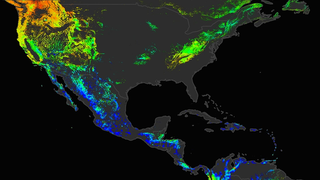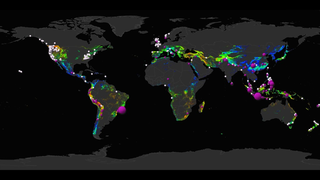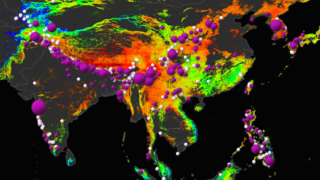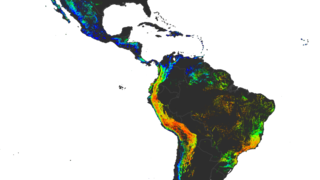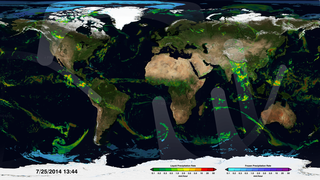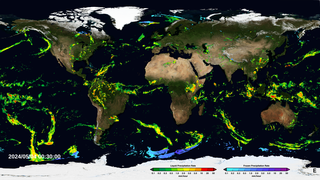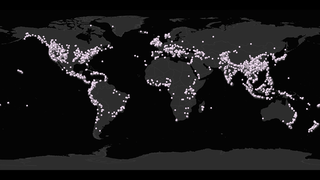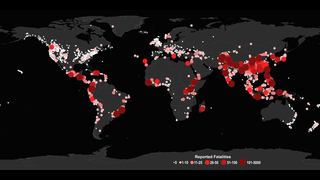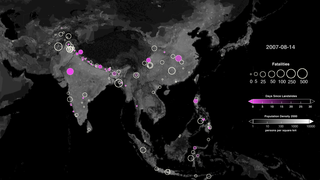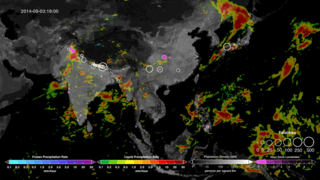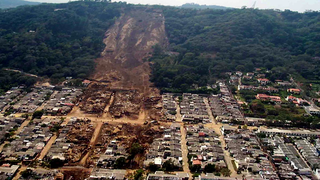New NASA Model Finds Landslide Threats in Near Real-Time During Heavy Rains
Overlaid with these nowcasts values are a Global Landslide Catalog(GLC) that was developed with the goal of identifying rainfall-triggered landslide events around the world, regardless of size, impact, or location. The GLC considers all types of mass movements triggered by rainfall, which have been reported in the media, disaster databases, scientific reports, or other sources. The visualization shows the distribution of landslides each month based on the estimated number of fatalities the event caused. The GLC has been compiled since 2007 at NASA's Goddard Space Flight Center and contains over 11,000 reports and growing. A new project called the Community the Cooperative Open Online Landslide Repository, or COOLR, provides the opportunity for the community to view landslide reports and contribute their own. The goal of the COOLR project is to create the largest global public online landslide catalog available and open to for anyone everyone to share, download, and analyze landslide information. More information on this system is available at: https://landslides.nasa.gov.
Landslides occur when an environmental trigger like an extreme rain event, often a severe storm or hurricane, and gravity's downward pull sets soil and rock in motion. Conditions beneath the surface are often unstable already, so the heavy rains act as the last straw that causes mud, rocks, or debris- or all combined- to move rapidly down mountains and hillsides. Unfortunately, people and property are often swept up in these unexpected mass movements. Landslides can also be caused by earthquakes, surface freezing and thawing, ice melt, the collapse of groundwater reservoirs, volcanic eruptions, and erosion at the base of a slope from the flow of river or ocean water. But torrential rains most commonly activate landslides.
For more information: https://www.nasa.gov/feature/goddard/2018/new-from-nasa-tracking-landslide-hazards-new-nasa-model-finds-landslide-threats-in-near-real



Used Elsewhere In
Source Material
Related
For More Information
Credits
Thomas A. Stanley (USRA): Scientist
Joy Ng (USRA): Producer
Ryan Fitzgibbons (USRA): Producer
Helen-Nicole Kostis (USRA): Lead Data Visualizer
Kasha Patel (Wyle Information Systems): Lead Writer
Horace Mitchell (NASA/GSFC): Support
Greg Shirah (NASA/GSFC): Support
Aaron E. Lepsch (ADNET Systems, Inc.): Technical Support
NASA's Goddard Space Flight Center
https://svs.gsfc.nasa.gov/12897
Mission:
Global Precipitation Measurement (GPM)
This item is part of this series:
Narrated Movies
Keywords:
DLESE >> Geology
SVS >> HDTV
DLESE >> Physical geography
GCMD >> Earth Science >> Land Surface >> Erosion/Sedimentation >> Landslides
SVS >> Mudslide
SVS >> Hyperwall
SVS >> Natural Disaster
NASA Science >> Earth
GCMD >> Earth Science >> Climate Indicators >> Land Surface/agriculture Indicators >> Landslides
GCMD >> Earth Science >> Human Dimensions >> Natural Hazards >> Landslides
SVS >> Mud Flow
SVS >> Global Landslide Catalog
GCMD keywords can be found on the Internet with the following citation: Olsen, L.M., G. Major, K. Shein, J. Scialdone, S. Ritz, T. Stevens, M. Morahan, A. Aleman, R. Vogel, S. Leicester, H. Weir, M. Meaux, S. Grebas, C.Solomon, M. Holland, T. Northcutt, R. A. Restrepo, R. Bilodeau, 2013. NASA/Global Change Master Directory (GCMD) Earth Science Keywords. Version 8.0.0.0.0
